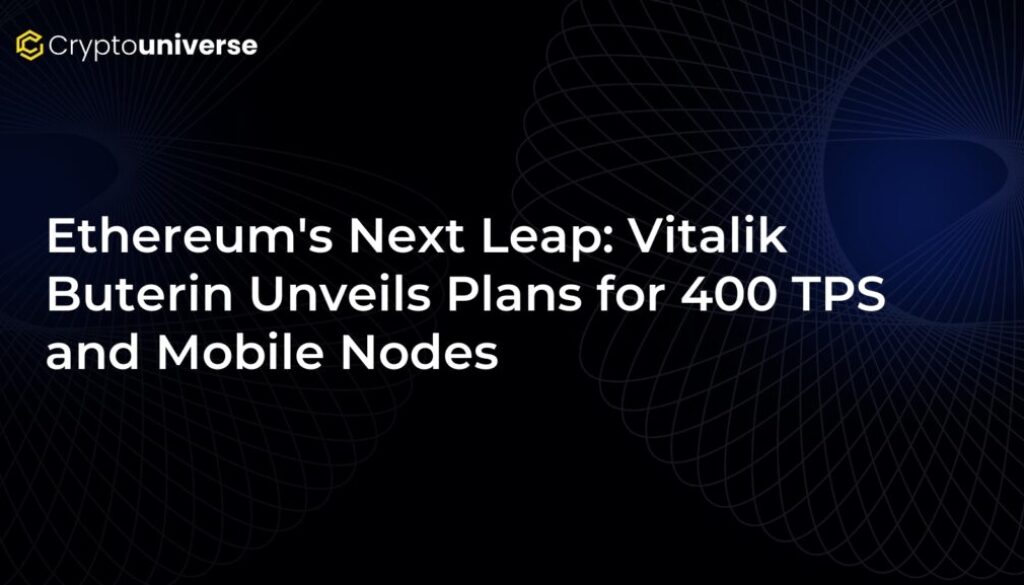Ethereum’s Next Leap: Vitalik Buterin Unveils Plans for 400 TPS and Mobile Nodes

Ethereum’s Ambitious Roadmap Revealed at ETHKyiv 2025
In a powerful display of resilience and innovation, the global Web3 community turned its attention to ETHKyiv 2025. While developers on the ground focused on building the future of privacy-first applications, Ethereum’s leadership, joining remotely, dropped bombshell announcements that chart a bold new course for the world’s leading smart contract platform.
Co-founder Vitalik Buterin and core developer Tomasz K. Stańczak outlined two transformative goals set to redefine Ethereum’s capabilities: achieving a massive increase in transaction speed and making it possible for anyone to run a full node from their smartphone. These upgrades are not just incremental improvements; they represent a fundamental leap towards making Ethereum more scalable, decentralized, and accessible to the masses.
Full Nodes in Your Pocket: The Mobile Revolution
One of the biggest hurdles to true decentralization has always been the hardware required to run a full Ethereum node. Currently, participants need powerful computers with significant storage to download and validate the entire blockchain history. This high barrier to entry forces many users to rely on centralized third-party services, creating potential points of failure and censorship.
Vitalik Buterin announced a groundbreaking solution to this problem. Thanks to advancements in zero-knowledge technology, specifically zkEVMs, the computational and storage requirements for running a node will be drastically reduced.
Here’s what this means for the average user:
- Run a node anywhere: Soon, users will be able to run a full, validating Ethereum node directly on a smartphone or even a smartwatch.
- Enhanced Decentralization: Lowering the barrier to entry will exponentially increase the number of nodes securing the network, making it more robust and resilient against attacks.
- Improved Privacy and Security: By verifying transactions themselves, users can achieve self-sovereignty and no longer need to trust intermediaries with their data.
This development is a cornerstone of the plan to fulfill the vision for
Supercharging Layer 1: The Road to 400 TPS and Near-Instant Finality
While mobile nodes tackle decentralization, Tomasz K. Stańczak addressed the critical need for speed and scalability directly on Ethereum’s mainnet. He confirmed an ambitious timeline for major performance upgrades designed to support the burgeoning Layer 2 ecosystem and provide a seamless user experience.
Key Milestones for Ethereum’s Core Infrastructure:
- 400 Transactions Per Second (TPS): Ethereum Layer 1 is officially targeting 400 TPS by the end of 2025. This represents a significant increase from current levels and will help alleviate network congestion and high fees.
- 3-Slot Finality: By late 2026, a new mechanism called 3-Slot Finality will be implemented. This will slash block confirmation times from a lengthy 15 minutes to a mere 36 seconds. For users, this means faster, more reliable transactions for everything from DeFi trades to NFT mints.
- Increased Block Gas Limit: The block gas limit will soon be raised to 60 million, with a target of 100 million later in the year. This allows more transactions and more complex computations to fit into each block, further boosting network capacity.
The Big Picture: A Web2 Experience with Web3 Values
These two major initiatives—mobile nodes and a supercharged mainnet—are deeply interconnected. The goal is to create a powerful, secure, and decentralized Layer 1 that can serve as the ultimate settlement layer for the entire Ethereum ecosystem, including dozens of Layer 2 rollups.
By increasing the speed and capacity of the mainnet while simultaneously making it easier for anyone to participate in securing it, Ethereum is paving the way for a future where decentralized applications can compete with the speed and convenience of traditional Web2 services.
As Vitalik Buterin aptly summarized, the mission is to “Make Ethereum private, censorship-resistant, and easy enough for anyone to use daily.” With these new upgrades on the horizon, that future is closer than ever.


